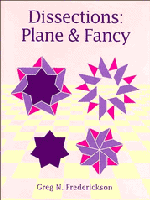Book contents
- Frontmatter
- Contents
- Preface
- 1 “Dat Pussle”
- 2 Our Geometric Universe
- 3 Fearful Symmetry
- 4 It's Hip to Be a Square
- 5 Triangles and Friends
- 6 All Polygons Created Equal
- 7 First Steps
- 8 Step Right Up!
- 9 Watch Your Step!
- 10 Just Tessellating
- 11 Plain Out-Stripped
- 12 Strips Teased
- 13 Tessellations Completed
- 14 Maltese Crosses
- 15 Curves Ahead
- 16 Stardom
- 17 Farewell, My Lindgren
- 18 The New Breed
- 19 When Polygons Aren't Regular
- 20 On to Solids
- 21 Cubes Rationalized
- 22 Prisms Reformed
- 23 Cheated, Bamboozled, and Hornswoggled
- 24 Solutions to All Our Problems
- Afterword
- Bibliography
- Index of Dissections
- General Index
8 - Step Right Up!
Published online by Cambridge University Press: 05 August 2012
- Frontmatter
- Contents
- Preface
- 1 “Dat Pussle”
- 2 Our Geometric Universe
- 3 Fearful Symmetry
- 4 It's Hip to Be a Square
- 5 Triangles and Friends
- 6 All Polygons Created Equal
- 7 First Steps
- 8 Step Right Up!
- 9 Watch Your Step!
- 10 Just Tessellating
- 11 Plain Out-Stripped
- 12 Strips Teased
- 13 Tessellations Completed
- 14 Maltese Crosses
- 15 Curves Ahead
- 16 Stardom
- 17 Farewell, My Lindgren
- 18 The New Breed
- 19 When Polygons Aren't Regular
- 20 On to Solids
- 21 Cubes Rationalized
- 22 Prisms Reformed
- 23 Cheated, Bamboozled, and Hornswoggled
- 24 Solutions to All Our Problems
- Afterword
- Bibliography
- Index of Dissections
- General Index
Summary
In Puzzles and Curious Problems, a posthumous collection of puzzles by the English puzzlist Henry E. Dudeney, the following problem appears: “A cabinetmaker had a perfect square of beautiful veneer which he wished to cut into six pieces to form three separate squares, all different sizes. How might this have been done without any waste?”
A pretty puzzle, and yet in its framing the master's mortising chisel had slipped: Just five pieces suffice to form a set of three separate squares. And the number of such sets would fill a large warehouse. Even Dudeney's prototype set requires no more than five pieces, as Dudeney's old American rival Sam Loyd had catalogued more than two decades earlier! Furthermore, displaying his own consummate craftsmanship, Loyd had even preserved a checkerboard pattern in his dissection.
Dudeney (1931b) based his 6-piece dissection on the smallest numerical identity that satisfies the specified requirements, namely, 22 + 32 + 62 = 72. Loyd (Home, 1908a) gave a 5-piece dissection for the same identity, shown with its checkerboard pattern in Figure 8.1.
This puzzle is remarkably rich even when we ask for 5-piece dissections. We needn't focus just on the case of 22 + 32 + 62 = 72, since there are an infinite number of integral solutions to x2 + y2 + z2 = w2 that have 5-piece dissections. We shall find that the same situation exists for x2 + y2 = z2 + w2.
- Type
- Chapter
- Information
- DissectionsPlane and Fancy, pp. 71 - 88Publisher: Cambridge University PressPrint publication year: 1997



